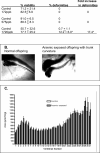Dose-responsive gene expression changes in juvenile and adult mummichogs (Fundulus heteroclitus) after arsenic exposure
- PMID: 20451245
- PMCID: PMC2900493
- DOI: 10.1016/j.marenvres.2010.04.003
Dose-responsive gene expression changes in juvenile and adult mummichogs (Fundulus heteroclitus) after arsenic exposure
Abstract
The present study investigated arsenic's effects on mummichogs (Fundulus heteroclitus), while also examining what role that gender or exposure age might play. Adult male and female mummichogs were exposed to 172 ppb, 575 ppb, or 1720 ppb arsenic as sodium arsenite for 10 days immediately prior to spawning. No differences were noted in the number or viability of eggs between the groups, but there was a significant increase in deformities in 1720 ppb arsenic exposure group. Total RNA from adult livers or 6-week old juveniles was used to probe custom macroarrays for changes in gene expression. In females, 3% of the genes were commonly differentially expressed in the 172 and 575 ppb exposure groups compared to controls. In the males, between 1.1 and 3% of the differentially expressed genes were in common between the exposure groups. Several genes, including apolipoprotein and serum amyloid precursor were commonly expressed in either a dose-responsive manner or were dose-specific, but consistent across genders. These patterns of regulation were confirmed by QPCR. These findings will provide us with a better understanding of the effects of dose, gender, and exposure age on the response to arsenic.
Figures





Similar articles
-
Arsenic exposure to killifish during embryogenesis alters muscle development.Toxicol Sci. 2012 Feb;125(2):522-31. doi: 10.1093/toxsci/kfr302. Epub 2011 Nov 4. Toxicol Sci. 2012. PMID: 22058191 Free PMC article.
-
Physiological changes and differential gene expression in mummichogs (Fundulus heteroclitus) exposed to arsenic.Aquat Toxicol. 2006 Apr 20;77(1):43-52. doi: 10.1016/j.aquatox.2005.10.014. Epub 2005 Dec 13. Aquat Toxicol. 2006. PMID: 16356559
-
Embryonic-only arsenic exposure in killifish (Fundulus heteroclitus) reduces growth and alters muscle IGF levels one year later.Aquat Toxicol. 2017 May;186:1-10. doi: 10.1016/j.aquatox.2017.02.020. Epub 2017 Feb 20. Aquat Toxicol. 2017. PMID: 28237603 Free PMC article.
-
Profiling microRNA expression in Atlantic killifish (Fundulus heteroclitus) gill and responses to arsenic and hyperosmotic stress.Aquat Toxicol. 2019 Jan;206:142-153. doi: 10.1016/j.aquatox.2018.11.009. Epub 2018 Nov 12. Aquat Toxicol. 2019. PMID: 30476744 Free PMC article.
-
In utero and early life arsenic exposure in relation to long-term health and disease.Toxicol Appl Pharmacol. 2013 Oct 15;272(2):384-90. doi: 10.1016/j.taap.2013.06.030. Epub 2013 Jul 13. Toxicol Appl Pharmacol. 2013. PMID: 23859881 Free PMC article. Review.
Cited by
-
Functional genomics to assess biological responses to marine pollution at physiological and evolutionary timescales: toward a vision of predictive ecotoxicology.Brief Funct Genomics. 2016 Sep;15(5):358-64. doi: 10.1093/bfgp/elv060. Epub 2015 Dec 22. Brief Funct Genomics. 2016. PMID: 26700295 Free PMC article. Review.
-
Synonymous single nucleotide polymorphism in arsenic (+3) methyltransferase of the Western mosquitofish (Gambusia affinis) and its gene expression among field populations.Ecotoxicology. 2021 May;30(4):711-718. doi: 10.1007/s10646-021-02376-8. Epub 2021 Apr 3. Ecotoxicology. 2021. PMID: 33811567 Free PMC article.
-
Arsenic alters transcriptional responses to Pseudomonas aeruginosa infection and decreases antimicrobial defense of human airway epithelial cells.Toxicol Appl Pharmacol. 2017 Sep 15;331:154-163. doi: 10.1016/j.taap.2017.06.010. Epub 2017 Jun 15. Toxicol Appl Pharmacol. 2017. PMID: 28625800 Free PMC article.
-
Arsenic exposure to killifish during embryogenesis alters muscle development.Toxicol Sci. 2012 Feb;125(2):522-31. doi: 10.1093/toxsci/kfr302. Epub 2011 Nov 4. Toxicol Sci. 2012. PMID: 22058191 Free PMC article.
References
-
- Ahlborn GJ, Nelson GM, Grindstaff RD, Waalkes MP, Diwan BA, Allen JW, Kitchin KT, Preston RJ, Hernandez-Zavala A, Adair B, Thomas DJ, Delker DA. Impact of life stage and duration of exposure on arsenic-induced proliferative lesions and neoplasia in C3H mice. Toxicology. 2009;262:106–113. - PMC - PubMed
-
- Ahlborn GJ, Nelson GM, Ward WO, Knapp G, Allen JW, Ouyang M, Roop BC, Chen Y, O'Brien T, Kitchin KT, Delker DA. Dose response evaluation of gene expression profiles in the skin of K6/ODC mice exposed to sodium arsenite. Toxicol. Appl. Pharmacol. 2008;227:400–416. - PubMed
-
- Andrew AS, Bernardo V, Warnke LA, Davey JC, Hampton T, Mason RA, Thorpe JE, Ihnat MA, Hamilton JW. Exposure to arsenic at levels found in U.S. drinking water modifies expression in the mouse lung. Toxicol. Sci. 2007;100:75–87. - PubMed
-
- ATSDR . Agency for Toxic Substances and Disease Registry. SUDHHS; PHS, City: 2007. CERCLA priority list of hazardous substances that will be the subject of toxicological profiles and support document. 2007.
Publication types
MeSH terms
Substances
Grants and funding
LinkOut - more resources
Full Text Sources
Medical
Molecular Biology Databases

